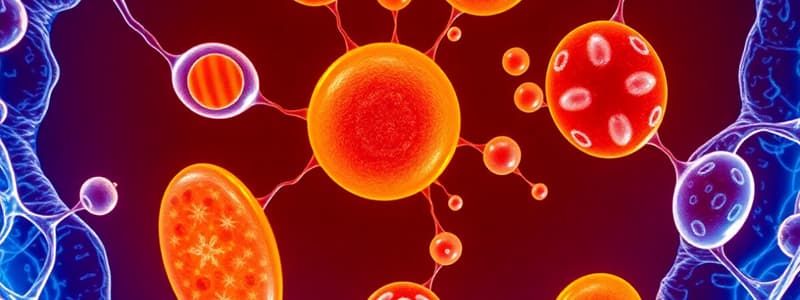Podcast
Questions and Answers
Which of the following correctly describes ribosomes?
Which of the following correctly describes ribosomes?
- Membrane-bound structures involved in lipid metabolism.
- Sites of protein synthesis that can be free or attached to the endoplasmic reticulum. (correct)
- Structures responsible for photosynthesis in plant cells.
- Organelles found only in prokaryotic cells, involved in detoxification.
What roles does the smooth endoplasmic reticulum play in the cell?
What roles does the smooth endoplasmic reticulum play in the cell?
- Modification of proteins for secretion.
- Protein synthesis and modification.
- Lipid synthesis, detoxification, and calcium storage. (correct)
- Photosynthesis and energy production.
Which structure is not found in prokaryotic cells?
Which structure is not found in prokaryotic cells?
- Ribosomes
- Cytoplasm
- Plasma membrane
- Nucleus (correct)
What is the primary function of mitochondria?
What is the primary function of mitochondria?
In which part of a eukaryotic cell does protein synthesis begin?
In which part of a eukaryotic cell does protein synthesis begin?
What function do lysosomes serve in the cell?
What function do lysosomes serve in the cell?
Which of the following statements about chloroplasts is correct?
Which of the following statements about chloroplasts is correct?
How is the plasma membrane described in cellular biology?
How is the plasma membrane described in cellular biology?
What is the principal purpose of the Golgi apparatus within a cell?
What is the principal purpose of the Golgi apparatus within a cell?
Cell division that produces gametes is known as?
Cell division that produces gametes is known as?
Flashcards
Cell
Cell
The basic unit of life that can function independently.
Plasma Membrane
Plasma Membrane
A selectively permeable barrier regulating substance passage in/out of the cell.
Prokaryotic Cells
Prokaryotic Cells
Cells without a nucleus or membrane-bound organelles, e.g., bacteria.
Eukaryotic Cells
Eukaryotic Cells
Signup and view all the flashcards
Nucleus
Nucleus
Signup and view all the flashcards
Ribosomes
Ribosomes
Signup and view all the flashcards
Mitochondria
Mitochondria
Signup and view all the flashcards
Chloroplasts
Chloroplasts
Signup and view all the flashcards
Cellular Respiration
Cellular Respiration
Signup and view all the flashcards
Photosynthesis
Photosynthesis
Signup and view all the flashcards
Study Notes
Cell Structure
- Cells are the fundamental units of life, exhibiting diverse shapes and sizes.
- All cells share core structures: a plasma membrane, cytoplasm, and genetic material.
- Prokaryotic cells (e.g., bacteria) lack a nucleus and membrane-bound organelles.
- Eukaryotic cells (e.g., plant and animal cells) contain a nucleus and various membrane-bound organelles.
- The plasma membrane is a selective barrier, regulating substance passage. Mainly composed of a phospholipid bilayer.
- Cytoplasm encompasses the region between the plasma membrane and the nucleus, including organelles.
- Cytosol is the fluid component of cytoplasm.
- The nucleus houses the cell's genetic material (DNA) and controls cellular activities.
- Ribosomes are protein synthesis sites; they exist freely in the cytoplasm or attached to the endoplasmic reticulum.
Organelles
- Endoplasmic Reticulum (ER): A membrane network for protein and lipid synthesis.
- Rough ER: Ribosome-studded, involved in protein synthesis and modification.
- Smooth ER: No ribosomes, crucial for lipid synthesis, detoxification, and calcium storage.
- Golgi Apparatus: Processes, sorts, and packages proteins and lipids for secretion or cellular use.
- Mitochondria: The "powerhouses" of the cell, responsible for cellular respiration and ATP production; contain their own DNA.
- Lysosomes: Contain enzymes for breaking down waste, cellular debris, and foreign substances.
- Vacuoles: Membrane-bound sacs for storage, transport, and maintaining turgor pressure (especially in plant cells).
- Chloroplasts (plant cells only): Sites of photosynthesis, converting light energy to chemical energy.
Cell Processes
- Cellular Respiration: The process of breaking down glucose to release ATP, occurring in mitochondria.
- Photosynthesis: The process by which plants, and some other organisms, convert light energy into glucose in chloroplasts.
- Protein Synthesis: Building proteins from amino acids, involving transcription (DNA to mRNA) and translation (mRNA to protein) stages; crucial role of ribosomes.
- Cell Division: A cell dividing into two daughter cells via mitosis (somatic cells) or meiosis (gametes).
- Cell Transport: Movement of substances across the cell membrane, encompassing passive transport (diffusion, osmosis) and active transport (energy-dependent).
- Endocytosis and Exocytosis: Processes for moving large molecules or bulk materials into or out of the cell, respectively.
Cell Types and Specializations
- Different cell types have unique shapes and structures reflecting their functions. Examples include muscle, nerve, and epithelial cells.
- Plant cells have a cell wall made of cellulose providing support and structure.
Studying That Suits You
Use AI to generate personalized quizzes and flashcards to suit your learning preferences.




